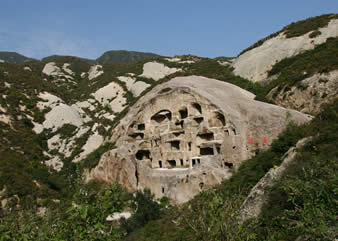Introduction to the Ruins of Beijing Guyaju
(The grotto )
 The ruins of Beijing Guyaju are located 20km to the northwest of Badaling Great Wall. Similar to Badaling Great Wall, the ruins are miraculous humanistic relics left over by the ancients in the long history of Yanqing County. They are known as ¡°mysteries of the time¡± and ¡°miracles of the time¡±. It has been conferred with the honorary titles of Beijing Key Cultural Relics Protection Unit, Beijing Famous Landscape Zone, China Teenager Science Promotion Education Base, Capital City Civilized Scenic Spot, Green Peace Scenic Spot, and Beijing Social Classroom for Primary and Middle School Students.
The ruins of Beijing Guyaju are located 20km to the northwest of Badaling Great Wall. Similar to Badaling Great Wall, the ruins are miraculous humanistic relics left over by the ancients in the long history of Yanqing County. They are known as ¡°mysteries of the time¡± and ¡°miracles of the time¡±. It has been conferred with the honorary titles of Beijing Key Cultural Relics Protection Unit, Beijing Famous Landscape Zone, China Teenager Science Promotion Education Base, Capital City Civilized Scenic Spot, Green Peace Scenic Spot, and Beijing Social Classroom for Primary and Middle School Students.
It is so far the largest cliff residence relics found in the country. The steep granite walls of the valley, opposing each other in less than 10 meters width, are chiseled with 147 cliff chambers in an area of about 100,000 square meters above the valley bottom. The stone chambers are of various sizes and shapes. Some are paralleled suites, while others are of two storeys. Some even look like three-room chambers of modern residential buildings. The largest chamber is separated into the upper and lower floors, supported with side rooms and corridor poles. They might be used for social gatherings or memorial ceremonies. The chambers are well equipped with doors, windows, kang beds, kitchen ranges, horse troughs, cupboards, and smoke channels. Close your eyes, and you are likely to smell the cooking smokes from the remote old days.
It has not yet been explained how cliff chambers were constructed. Anyway, they have illustrated the magic achievements of ancient architectures with their imposing and elaborate craftsmanship. The 147 cliff chambers do not have any poles or girders. But they are designed into building structures. They do not have any ladders or boards. But they are placed in well-connected multi-layers. The chambers look either round or square to meet aesthetic principles, a showcase of primitive aesthetic tastes. Pondering in such cliff chambers, we feel like staying in a Buddhist Scripture Library of the past days. All these cliff chambers are something like character-free books to reproduce shining spears and armored horses, and slash-and-burn cultivations of the old days. People of the later generations will read out heroic spirits and the theme of war and peace from the congealed air. The site presents a number of distinct vein rocks going through 130 million years of geological changes. People will be amazed at the mystery of nature, as they see the naturally generated cliff walls in the mountains. The cliff chambers are hailed as China¡¯s biggest maze, Beijing¡¯s second Zhoukoudian, Beijing¡¯s Dunhuang, and Goldbach Conjecture in the humanistic art field. Du Xianzhou, President of Architectural Society of China under Chinese Academy of Sciences, said they are the blank pages in the history of architecture, treasures to be carved in the cultural relics history, and maidens of the tourism industry raised in lady¡¯s private rooms.
As a result of years of development, the Ruins of Beijing Guyaju have expanded from the previous reception-based scenic spot into a comprehensive service site integrating residence, cuisine, traffic, touring and entertainment. At the end of 2007, the Ruins of Beijing Guyaju was listed among the 60 scenic spots in Beijing to greet the Olympic Games. In order to facilitate tourists and make the place safer, we constructed barrier-free channels and railings along the road. The Wanghu Hotel in the scenic spot could accommodate to 100 tourists. Dinners are arranged with wild fish from Ganting Reservoir. They are supported with pollution-free vegetables raised in the scenic spot to make you healthy and comfortable.
Yanqing County boasts rich tourism resources. It is known as the resort in summer days. In addition to the 1,000-year-mystery Ruins of Beijing Guyaju, it has world-famous Badaling Great Wall, Residual Great Wall, Wildlife Park, Longqing Gorge that is rated as a petite Lijiang river in north China, Wild Duck Lake that is the largest wetland park in Asia, silicified woods in the National Geology Park, Songshan that is a state-level forest protection zone, and charming Yudu Mountain and Red Leave Mountain¡. We have worked with Songshan, Wild Duck Lake and Yanqing Museum, the city-level resources units for the Social Classroom, to jointly push forward the elite tourism line sponsored by us ¨C Journey to Yanqing ¨C Back Garden of Beijing.
Welcome to Yanqing, the summer resort and charming back garden of Beijing!
Ticket prices: 40 yuan/adult, 20 yuan/student
Address: Zhangshanying Town, Yanqing, Beijing Zip code: 102115
Tel: 010¡ª69110333 Fax: 010¡ª69119426
Traffic: Take No.919 Bus at Deshengmen, get off at Yanqing Nancaiyuan Station, and transfer No. 920 Bus to arrive at Dongmenying Station
E¡ªmail: beijingguyaju@163.com
Beijing Tourism Consultation Service Center, Yanqing Outlet
Address: No.2-A South Guishui Street, Yanqing, Beijing, Zip code: 102100
Tel: 010¡ª81191011 Fax: 010¡ª81197633
http://www.yqtour.gov.cn



